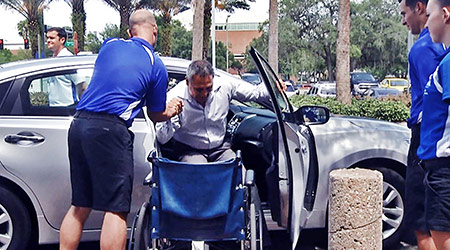Challenging market dynamics such as shrinking budgets and new legislation have changed the healthcare landscape dramatically. Hospitals are consolidating to create larger, but fewer, healthcare systems. And, increased competition and more stringent reimbursement policies are forcing a cultural transformation around patient satisfaction.
In the past, patient satisfaction was outcome driven. Patients went to the hospital to receive quality care and positive outcomes. But today's patients are consumer-oriented. They are more informed and involved in their own medical care and have more options to choose from when it comes to healthcare delivery.
Now, in exchange for their patronage and loyalty, patients demand more from their healthcare experience. They still expect high quality, patient-centered care, but they are also looking for an all-inclusive four-star hotel experience.
Was there a valet to help park the car, did a concierge greet them and help them check in, did the lobby smell and look sparkling clean, did they have to wait long for their room, did someone sit with them while they waited for their lab results, was there custom-order room service?
These value-added amenities, conveniences, and hospitality have become the new competitive differentiator for healthcare organizations and helped them elevate their brands. Because when patients feel they are treated exceptionally well and are getting good value for their money, they are more likely to:
• Have a better and faster outcome
• Become a patient for life
• Refer other potential patients
• Rate the healthcare system higher in satisfaction surveys
Defining today's new patient experience
Now that we've established its rising importance, what exactly is the "overall patient experience?" The Beryl Institute describes it as “the sum of all interactions shaped by an organization’s culture that influence patient perceptions across the continuum of care.”
More simply put, it's not just about the medical treatment a patient receives, but rather the feelings and perceptions that are formed over the course of their entire visit. All actions and encounters -- from the minute they first enter the parking lot to the time they leave -- are meaningful moments that define their total experience.
From parking the car to serving food, cleaning a room to keeping the lights working, these are clear opportunities to impact the patient’s hospital experience. How the patient perceives these interactions has an impact on whether it was a positive or negative experience. Their perception is their reality and therefore becomes the healthcare organization's reality.
Trends for elevating patient satisfaction
With the amount of business and revenue now at stake, hospitals and healthcare organizations are looking for creative ways to focus on and improve the patient experience to attract and retain patients, boost HCHAPS satisfaction scores, and increase Medicare reimbursements. Here are some of today's most innovative strategies and trends being leveraged:
Rise of the CXO
Healthcare organizations who have realized the power of the patient experience, are adding the role of chief experience officer -- or CXO -- to their healthcare C-suite. While the role is still relatively new in the industry, it's a sign an organization is serious about creating a patient-centered culture and investing in programs and solutions to better shape the patient experience.
The patient experience has many touchpoints and extends well beyond patient care. A CXO helps define the patient experience strategy and coordinates and oversees the types of resources and technology necessary to implement and improve it. Hiring a CXO as a patient advocate demonstrates a commitment to walking the walk, not just talking the talk when it comes to ensuring the top priority remains on patients and their guests.
Innovative healthcare support services providers are also developing patient experience tools and programs that CXOs can leverage to enhance their own strategies and programs.
Technology to drive excellence at the point of service
The physical environment creates some of the strongest impressions and has great impact on the total patient experience. Patients expect and deserve a comfortable, well-lit, and safe healing environment. How well a facility is maintained can directly affect their outcomes and satisfaction levels.
But often, large healthcare facilities have experienced expansion and acquisitions over decades that have created disparate systems that don't work well together. This lack of centralization and cohesion creates operational inefficiencies that can negatively affect how facilities are maintained.
Leveraging an enterprise-wide technology platform to consolidate, integrate, and automate systems helps drive efficiency and productivity, lower costs, and provide transparency and visibility of facility operations and data.
Web-based automation technology allows maintenance teams to more efficiently schedule and manage maintenance personnel and tasks and have instant access to all work order data and history. Technicians are able to work from mobile devices, speeding the work order process and allowing them to be more proactive in addressing facility needs and delivering an optimal healing environment for patients, guests, and employees.
Hospitality inspired services and training
As mentioned, patients have more options than ever when it comes to their medical facility choices, and value is front and center in today's healthcare equation. To attract more patients and increase revenue, many healthcare organizations are starting to offer hospitality services inspired by high-end hotels and restaurants.
These upscale amenities and conveniences drive perceptions of value and service quality that lead to an enhanced experience. Popular hospitality elements include:
• Valets
• Doormen
• Concierges
• Custom-order room service
• Gourmet food and restaurant-style dining
• Starbucks-like coffee kiosks
Rob Nonnweiller, CCP, is the Senior Vice President of Operations at ABM Healthcare.

 Building Sustainable Healthcare for an Aging Population
Building Sustainable Healthcare for an Aging Population Froedtert ThedaCare Announces Opening of ThedaCare Medical Center-Oshkosh
Froedtert ThedaCare Announces Opening of ThedaCare Medical Center-Oshkosh Touchmark Acquires The Hacienda at Georgetown Senior Living Facility
Touchmark Acquires The Hacienda at Georgetown Senior Living Facility Contaminants Under Foot: A Closer Look at Patient Room Floors
Contaminants Under Foot: A Closer Look at Patient Room Floors Power Outages Largely Driven by Extreme Weather Events
Power Outages Largely Driven by Extreme Weather Events